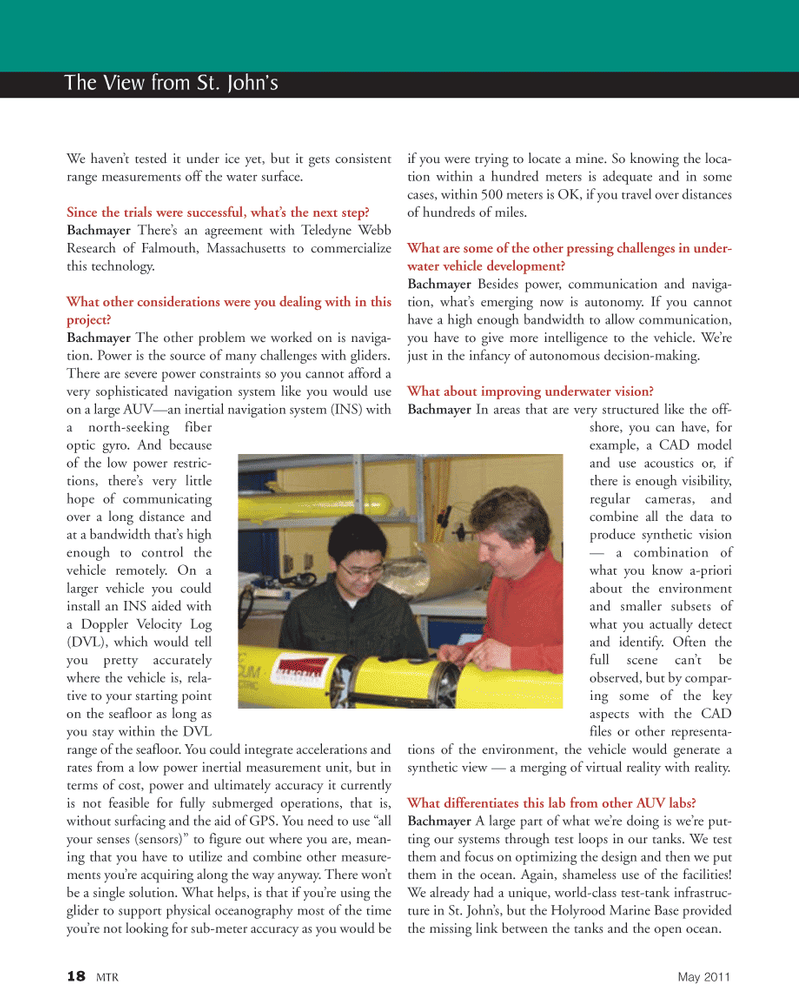
Page 18: of Marine Technology Magazine (May 2011)
Subsea Defense Edition
Read this page in Pdf, Flash or Html5 edition of May 2011 Marine Technology Magazine
18 MTR May 2011
We haven’t tested it under ice yet, but it gets consistent range measurements off the water surface.
Since the trials were successful, what’s the next step?
Bachmayer There’s an agreement with Teledyne Webb
Research of Falmouth, Massachusetts to commercialize this technology.
What other considerations were you dealing with in this project?
Bachmayer The other problem we worked on is naviga- tion. Power is the source of many challenges with gliders.
There are severe power constraints so you cannot afford a very sophisticated navigation system like you would use on a large AUV—an inertial navigation system (INS) with a north-seeking fiber optic gyro. And because of the low power restric- tions, there’s very little hope of communicating over a long distance and at a bandwidth that’s high enough to control the vehicle remotely. On a larger vehicle you could install an INS aided with a Doppler Velocity Log (DVL), which would tell you pretty accurately where the vehicle is, rela- tive to your starting point on the seafloor as long as you stay within the DVL range of the seafloor. You could integrate accelerations and rates from a low power inertial measurement unit, but in terms of cost, power and ultimately accuracy it currently is not feasible for fully submerged operations, that is, without surfacing and the aid of GPS. You need to use “all your senses (sensors)” to figure out where you are, mean- ing that you have to utilize and combine other measure- ments you’re acquiring along the way anyway. There won’t be a single solution. What helps, is that if you’re using the glider to support physical oceanography most of the time you’re not looking for sub-meter accuracy as you would be if you were trying to locate a mine. So knowing the loca- tion within a hundred meters is adequate and in some cases, within 500 meters is OK, if you travel over distances of hundreds of miles.
What are some of the other pressing challenges in under- water vehicle development?
Bachmayer Besides power, communication and naviga- tion, what’s emerging now is autonomy. If you cannot have a high enough bandwidth to allow communication, you have to give more intelligence to the vehicle. We’re just in the infancy of autonomous decision-making.
What about improving underwater vision?
Bachmayer In areas that are very structured like the off- shore, you can have, for example, a CAD model and use acoustics or, if there is enough visibility, regular cameras, and combine all the data to produce synthetic vision — a combination of what you know a-priori about the environment and smaller subsets of what you actually detect and identify. Often the full scene can’t be observed, but by compar- ing some of the key aspects with the CAD files or other representa- tions of the environment, the vehicle would generate a synthetic view — a merging of virtual reality with reality.
What differentiates this lab from other AUV labs?
Bachmayer A large part of what we’re doing is we’re put- ting our systems through test loops in our tanks. We test them and focus on optimizing the design and then we put them in the ocean. Again, shameless use of the facilities!
We already had a unique, world-class test-tank infrastruc- ture in St. John’s, but the Holyrood Marine Base provided the missing link between the tanks and the open ocean.
The View from St. John’s

 17
17

 19
19
